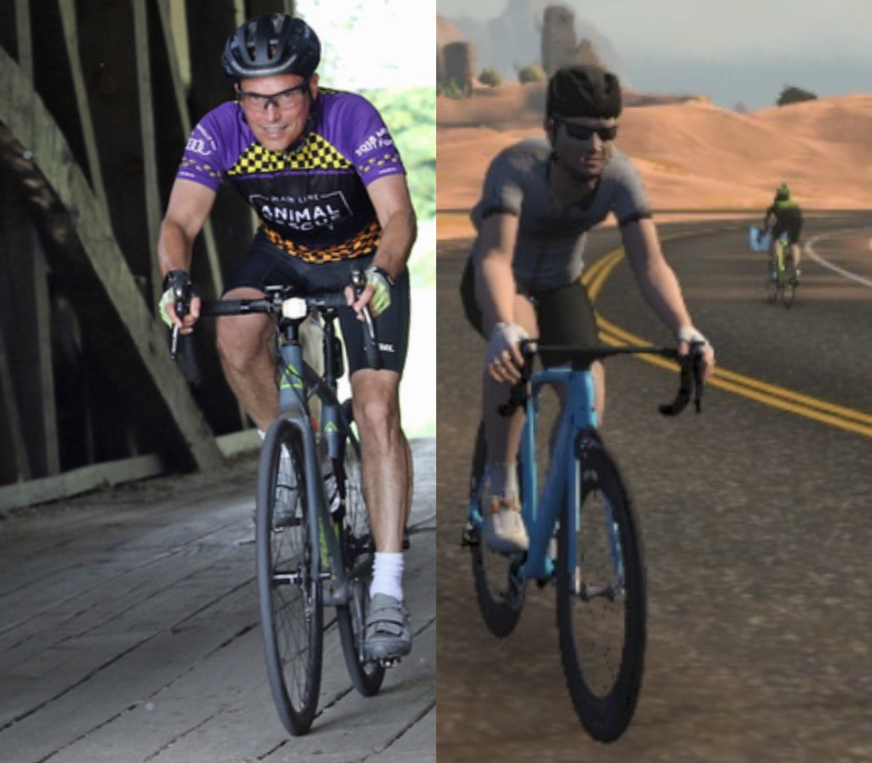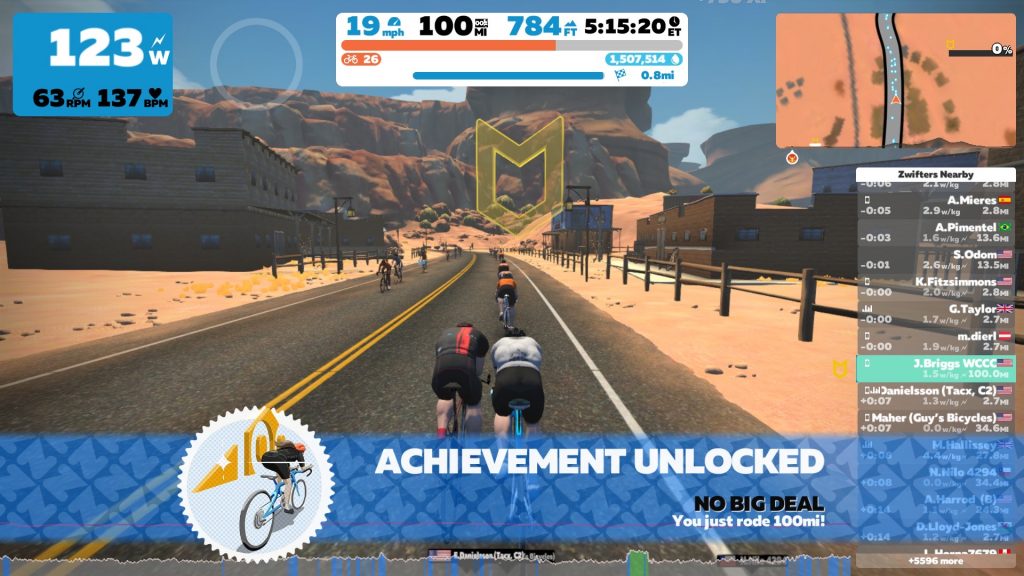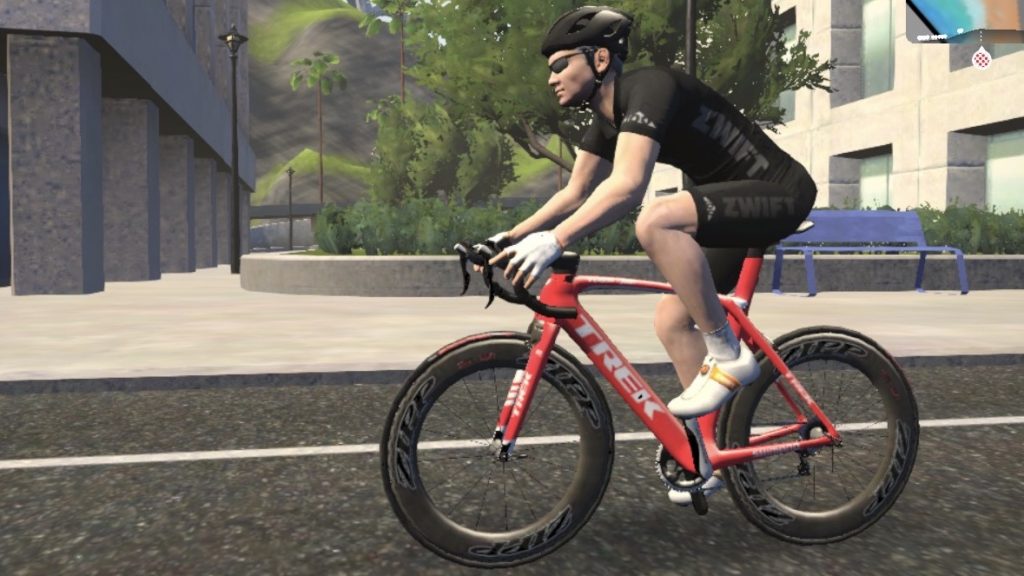Which is harder, a 100-mile century ride on the road or a 100-mile century ride in Zwift? Is zwift harder than riding outside? Riding 100 miles isn’t particularly easy even under the best circumstances, and involve many hours of cycling, but there’s definitely a difference between Zwift and riding outside. Having done both, I thought a quick comparison might be of interest to someone who has done one and is contemplating the other. This isn’t a scientific comparison, and I don’t claim that I’m an authority on Century rides, but I think maybe I can provide some insights…

The Road Century
For me, at my level of fitness and in the moderately hilly area I live in, a road century is about a seven-hour affair, when rest stops are factored in. I wrote about my first and second centuries in this blog, and I found the experience to be fairly similar in both. I was better prepared for the first one, but the second was easier, and in the end they both felt like they took more or less the same effort. Anyway, please check out those blog entries if you haven’t done a road Century and want to hear a little more about that experience.
The Zwift Century
The Zwift platform (along with technologies such as the Wahoo Kickr and Climb) does a lot to bridge the gap between riding on, say, rollers and riding outdoors. It’s certainly not the same experience, though, and after having done a metric century on Zwift, I was curious to see what the full Century experience would be like.
Well, when I said I was curious, I mean I was curious in the sense of “I wonder what that would be like?”, not in the sense that I really planned to find out. Still, as a completionist, that black Zwift jersey —exclusive to those who’ve done a 100 mile ride— did beckon to me. Then again, I knew that even if it was easier it was still going to be several hours on the trainer, and that part wasn’t terribly enticing.
Finally, fate intervened, and the indoor Century plan was back on. The Main Line Animal Rescue bike event went “virtual” this year (2020), and they moved it up to June to boot. Although this is the event for which I do all of my fundraising, I have to admit that this year I nearly sat it out. I was getting tired of all of the usual outdoor events being canceled or converting to “virtual” events (“virtual” basically means “do whatever you want to do”), and with the local bike club canceling their group rides I was really having trouble finding any motivation.
There was about a week to go before the event when I realized that if I did take a pass this time, I would certainly regret it when October rolled around and there wasn’t a big bike event fundraiser for me to get involved in. After all, the dogs and cats still needed care, and with so many people out of work and/or afraid to leave their homes, it hasn’t been a great year for fundraising in general. So although I usually spend a couple of months fundraising, this time I had a week and I had to figure out what to do as my virtual event.
My first thought was to do a Century ride in Zwift, mostly because it seemed like a kooky idea that would appeal to donors and also felt like the sort of thing that wasn’t really as hard as it sounds. And I hadn’t really trained for this, so I was definitely looking for something that wasn’t as hard as it sounds!
Back to Fuego Flats
At the risk of suffering an even greater level of boredom than I experienced in my metric century, I decided that my 100-miler would be done on a route called “Tempus Fugit” in the Fuego Flats area of Watopia, Zwift’s main bicycling paradise. Fuego Flats is, like it sounds, just about completely flat, with grades ranging from -1% to 2%. There are no stop signs, no stop lights, no traffic (except other bicycles and runners that you cannot collide with) and no weather except the weather in my basement. This should be just about optimal for a long ride.
Unlike the metric Century Zwift ride, I opted not for the TT bike but for my regular (Zwift) bike, the Trek Madone with the Zipp 808 wheels. My thinking was that on a Sunday morning (particularly with most of the world still in pandemic lockdown and riding indoors) there would be a lot of other cyclists on the route and it wouldn’t be so hard to find another person or two to draft off of. Also, since the TT bike does not benefit from the draft and you cannot crash into other bikes, when you’re riding the TT bike the others on the road are completely irrelevant, and that was just a little more boring than I was ready to deal with. I am not entirely sure whether riding a TT bike or a bike like the Madone in the draft is faster, but did try a little experiment in the week leading up to this ride and I believe the regular bike in the draft is faster.
As it turns out, on the day of the event I got even more help than anticipated. My brother joined me on the ride and rode the first segment (the first forty miles) as my domestique, so I always had someone to draft off of. That was, predictably, my fastest segment, averaging somewhere between 23-24 mph. Nowhere in the real world have I ever gone that fast for that long. I’ve never had the opportunity to cycle in a Fuego Flats type of environment with people to draft off the whole way, so I have no way of knowing whether I’d be able to pull off speeds like that in the real world, but suffice to say this seemed like pretty much ideal circumstances.

I took a ten minute break at the 40 mile mark, where I lost my domestique (strangely, he had other things to do that day than sit in his own basement and spin, but I thank him greatly for the help). I re-started much the same as I had left off, but to stave off boredom I started watching one of the ESPN 30 for 30’s (the Lance Armstrong one, naturally. Spoiler alert: this guy has no self-awareness). Since I couldn’t watch TV and try to find people to draft off I switched then to the TT bike for the remainder of the ride. Slower than the Madone had been, but probably faster in clean air. You can see from the chart that my speed drops off noticeably after the 40 mile mark, but I can’t really say how much of that is aero and how much of that is just good old fatigue.
The Mile 70 Wall
I have noticed that on each of the Century rides I’ve done there’s a psychological barrier at the 70 mile mark. Miles 70-80 are the worst, and although I am not entirely sure why that is I suppose it is because at that point I’ve been riding long enough to be feeling sore, but I’m not close enough to the end to start focusing on my post-ride meal(s).
Just like the outdoor centuries, the mile 70 wall was still a thing. I didn’t really contemplate quitting as I have done before, but it is definitely the psychological low point of the ride. I had decided on breaks at 40, 70, and 90 miles (and I was happy later with those choices) to give myself a little break before the stretch at 70 miles, and I’m happy I did. I grabbed myself a bread roll and started rationing my Bloks. I had one GU left over for this ride, but it was one of the chocolate outrage ones, and those things are like candy and best saved for the end of a ride.
The break at mile 90 was similar to the last rest stops on my outdoor Centuries, just long enough to reset. At that point in a ride, it’s pretty hard to get re-started, so you don’t want the break to be too long. Plus, at that point you’re only 10 miles from the end, and I was definitely ready to be done.
As the graph shows, I was gradually slowing down. This ride is a little over 9 laps of Tempus Fugit, I think, and Zwift gives you a time for the lap (1/2 lap, actually) so I was quite aware during the ride that my last few laps were each about 2-3% slower than the one before. I was slowly running out of gas. Additionally, although the grade on the route only varies between -1% and 2%, at this point in the ride I didn’t even have to see the screen to know what the gradient was. When I hit the 2% section I thought to myself “oh, no, the hill again!”
But then, with fairly little fanfare (just the banner announcing that I’d gotten the badge for the hundred mile ride, which Zwift calls the “No Big Deal” badge), it was over.

So, now the question you’ve been waiting to be answered…
Is riding a Century in Zwift harder or easier than riding a Century outside on the road?
Based on my limited experience, I’d have to say it was easier. Definitely easier, and for one major reason: because there are no stop signs, stop lights, blind corners, traffic, or any other reason why you’d need to stop, your average speed in Zwift will be way faster than anything you could achieve on normal roads. In fact, my time for the “Tour de Mon Sous-Sol” as I call it was more than an hour faster than my fastest outdoor Century. After five plus hours on the bike doing this, I was very happy to not have to ride for another hour or more. Plus, my ride was climate controlled and I had complete discretion over the rest stops, etc. (and my wife came down every now and then to take photos for our social media posts — this was a fundraiser, after all!)
All of that said, if I were properly trained up I think I would pick the outdoor Century every time. The indoor ride was boring, and I don’t think it would have been significantly less boring if I hadn’t chosen to do 8 or 9 laps of Tempus Fugit. Outdoors there is scenery, navigational challenges to exercise your mind, comraderie, all the things that make cycling fun. Plus, this indoor century was almost completely in the saddle, and it is considerably less comfortable than the variability you get when riding outside. (I’ve spoken in earlier posts about the way the bike is clamped to the trainer and the unnatural feeling that results.) I’m very happy to be a Zwifter, but it’s still second best to riding outdoors.
Final Thoughts after the Zwift Century
In the end, I raised $1060 for Main Line Animal Rescue, which I was super-excited about. I even had donors who found the fundraiser through this blog! It’s a great feeling to be able to help out the dogs and cats of MLAR, so on that account alone it was definitely worth it.
Plus, I now have the coveted black Zwift jersey. My avatar is never going to take it off.



Leave a Reply